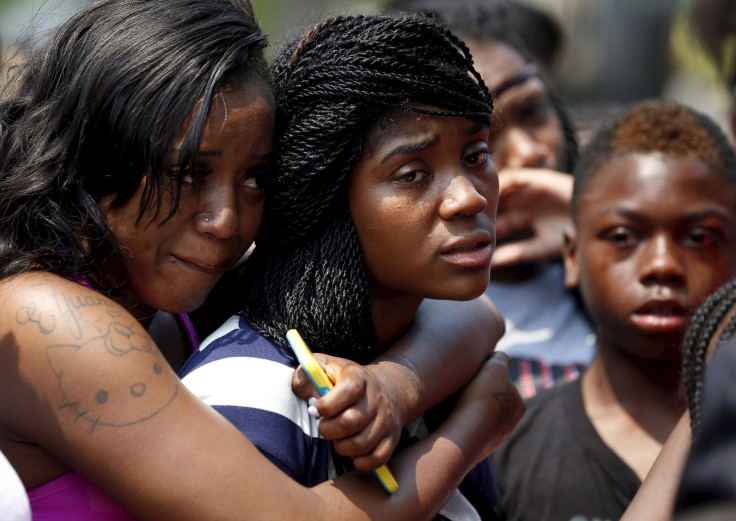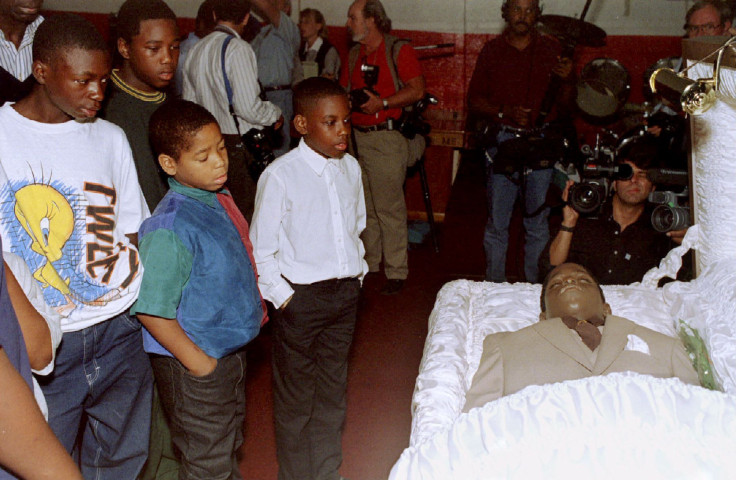Obama's Gun Control Plan And Gang Violence In American Cities: Should Urban Communities Blame Crime On Guns Or People?

Pam Bosley doesn’t feel joy when she hears gospel music anymore. Now, at the sound of a bass line, she is forced to remember the day her 18-year-old son Terrell was gunned down by gang members as he and fellow church musicians loaded their instruments into a car parked outside a sanctuary in Chicago. Terrell had wanted to attend college and aspired to a career in the predominantly African-American music genre.
But he lost that future a decade ago, in part, because someone falsely associated him with one of the city’s warring street gangs, his mother said. And it’s entirely possible the yet-to-be-caught culprit murdered Bosley’s son with a weapon illegally trafficked into one of Chicago’s violence-plagued neighborhoods from a state with relaxed regulations.
“Black people don’t make guns,” she said. “So, if we’re not making the guns [in Chicago], the guns are coming from somewhere else.”
Bosley, along with many other families touched by gun and gang violence in cities across the country, found hope this week in President Barack Obama’s executive action aimed at closing loopholes that have allowed legally purchased guns to end up on American streets in the hands of criminals and gang members. Amid an ongoing national debate about the alarming rate of U.S. gun violence, advocates for gun control argue violence in urban communities like Chicago, where the flow of guns from neighboring states with looser gun laws is said to be a large part of the problem, could be stymied with stricter regulations. Second Amendment activists, however, have blamed gun abuse problems in Chicago and urban cities nationwide on the social values of most victims, which they said can’t be fixed by restricting access for law-abiding citizens.
“We all know guns don’t get up and run across the street and shoot somebody,” said Bill Dowden, legislative director for the state rifle and pistol association in Indiana where lax gun laws have allowed private parties to transfer firearms without background checks or a record of the sale. But Dowden said those transactions can’t be the scapegoat for Chicago’s gun violence problems. “It’s the people who misuse [guns], just as they do alcohol and automobiles,” he added.
A Countrywide Problem For Minority Youth
Nationally, gun violence kills more than 32,000 people every year, but the toll is deeply felt in communities of color. In 2010, black males 15 to 19 years of age were nearly 30 times as likely as white males, and more than three times as likely as Hispanic males of similar age, to be killed in a gun homicide, according to federal law enforcement data.
Much of the violence is driven by an estimated 1.4 million gang members in the U.S., 88 percent of whom operate on city streets. The FBI’s National Gang Threat Assessment report in 2011 showed there were more than 33,000 active gangs on the streets and in prisons.
Chicago, a city of more than 2.7 million residents, had a public high school graduation rate of nearly 70 percent for the 2014-15 school year. The national graduation rate was 81 percent during the 2012-13 academic year, according to the U.S. Department of Education. Indianapolis, the largest city in Indiana at nearly 853,000 residents, had a reported graduation rate of 66.5 percent in 2014.

Like Chicago, Indianapolis was ranked in the top 10 most violent cities in the nations in 2014, based on crime statistics. But Indiana, unlike Illinois, allows open carry of firearms, a distinction that pro-gun activists often tout as making communities safer. Chicago, which was ranked No. 1, saw nearly 500 homicides in 2015, a 17 percent increase over 2014. Despite last year's high figure, it was about half that in 1974 when 970 homicides were committed.
“Criminals don’t buy guns. They either steal them or get them from straw man purchases,” said Leonard Grummel, a retired law enforcement professional and owner of Len’s Gun Shop in South Bend, Indiana, about 100 miles from Chicago. He expressed his anger over the president’s executive actions Wednesday, using racial epithets in reference to Obama.
“All this mayhem and consternation is brought about by socialist, liberal policies,” Grummel said of Chicago. “It’s because of their anti-gun attitude” in the state of Illinois, he added.
Finding Freedom From Violence
Gun control advocates said they were glad Obama is focusing on accountability and not shaming families touched by violence, many of whom are actively working to end the cycle of violence through grassroots initiatives. “It’s not just a societal problem,” said Bosley, co-founder of the Chicago victims support and youth mentoring group Purpose Over Pain. “It’s getting into everybody’s community. Just like [pro-gun activists] want their pursuit of happiness, I want mine. I want to have freedom from violence in my community,” she added.
Obama acknowledged the violence in his adopted hometown, during remarks about gun control delivered Tuesday from the White House. Children are stolen from families “who never imagined that their loved one would be taken […] by a bullet from a gun,” he said, wiping away tears. “Every time I think about those kids it gets me mad. And by the way, it happens on the streets of Chicago every day.”
Along with increased resources for the enforcement of existing federal gun laws, Obama has directed his administration to require background checks on guns sold outside of commercial dealership, over the internet and at gun shows. The executive orders also require all gun dealers, whether they are “brick and mortar” or occasional gun show vendors, to become federally licensed, conduct background checks and keep records of all sales.
The national laws have been on the books since the mid-1990s after the passage of the Brady Handgun Violence Prevention Act. A report on illegal guns released last year by Chicago officials shows 60 percent of firearms confiscated by city police from 2009 to 2013 came from states with lax gun laws. About 19 percent of Chicago’s illegal guns came from Indiana, whose state border is less than 30 miles southeast of downtown.
Catching Gun Traffickers & Reaching Perpetrators
Part of Obama’s gun control action is aimed at people who are illegally engaged in the business of firearm sales, said Mike McLively, staff attorney at the Law Center To Prevent Gun Violence in San Francisco. If working properly, expanded background checks and dealer license requirements establish additional ways to track the origins of guns and crack down on traffickers. “It’s a modest step, but because it’s national, it has a chance of helping,” McLively said.
But the tougher requirements could make criminals out of gun hobbyists who want to sell weapons responsibly to a neighbor without a middleman or cumbersome bureaucracy, said Richard Pearson, executive director of the Illinois State Rifle Association. He sees the lack of quality education as the root cause of city violence. “I don’t think it’ll stop gang violence at all,” he said of Obama’s gun control plan. “I would strongly suggest that they take all this money that they’re going to spend on [enforcement] and make sure that those kids are going to get an education,” he added.
Marc Morial, president and CEO of the National Urban League, a New York City based civil rights organization for African-Americans, said economic opportunity and good schools are part of a holistic approach to reaching at-risk youth. However, “expanded background checks mean fewer guns on the streets, and fewer lives lost,” Morial said in a statement. “Gun safety measures are just one component of curbing urban violence, but they are a vital component,” he said.
The question of whether gun-related gang violence is a problem of values or access has plagued communities across the nation, yielding different results. Richmond, California, for example, has implemented non-law enforcement measures to curb its once skyrocketing murder rate, among more than 107,000 residents.
From 2005 to 2012, African-Americans in Richmond made up 73 percent of homicide victims, according to the U.S. Department of Justice. But after the City Council created in 2006 the Office of Neighborhood Safety, which identifies people most at risk of street violence and helps them find other sources of employment, the tide turned. By 2013, the city recorded just 16 homicides, the lowest number seen in more than three decades, according to an impact study on the neighborhood safety program.
“We’ve engaged these young men who are most impacted by gun violence, and who are considered the most lethal young men as it comes to gun violence,” said DeVone Boggan, Richmond’s neighborhood safety director. “We see them as a part of the solution.”
Through the safety office’s “Operation Peacemaker Fellowship” internship program and the “Brotherhood of Elders” mentoring network, young men of color in Richmond who participate made different life choices because they were shown what life looks like when they put down the guns and better themselves, Boggan said. He’s not convinced Obama’s gun control measure will reduce the number of illegal street guns, but he said doing nothing about them will ensure the violence eventually touches other communities.
'Skin In The Game'
Joy McCormack wants to change how people see victims of urban gun violence. Most think that someone murdered in Chicago is nearly always black, poor and gang-affiliated, said McCormack, a founder of the victims group Chicago Survivors. Her son, Frankie Valencia, 21, was gunned down in 2009 during his senior year at DePaul University in Chicago.
He didn’t come from poverty and had his heart set on being the first Hispanic occupant of White House. Many black victims also have similar stories: Nothing in the deceased’s young life suggests exposure to violence.
“We have to get past stereotyping the victims and get to the real issues of why gun violence is happening,” McCormack said of the debate between gun control advocates and Second Amendment activists. “As long as you can make it an us-versus-them proposition, you believe that you don’t have skin in the game.”
© Copyright IBTimes 2024. All rights reserved.






















